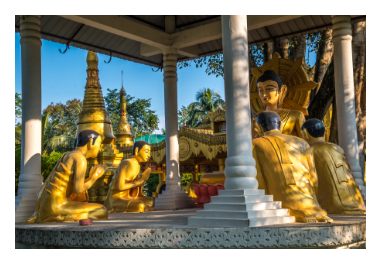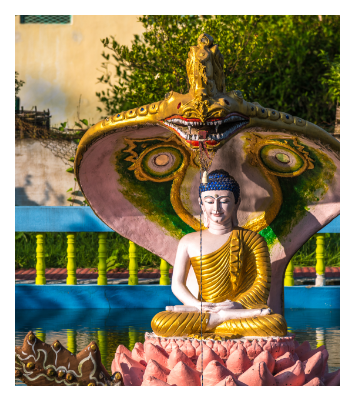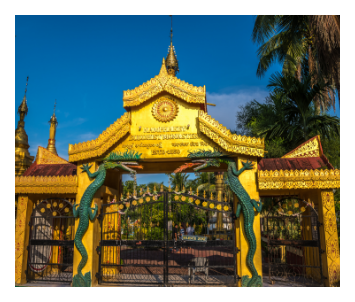

Buddhism is a religion that has enriched Assam's diversity of cultures. The roots of Buddhism are said to have emerged with Thera Dhitika, a disciple of during the reign of Emperor Ashoka paving the faith of Buddhism across Kamrupa and the neighbouring areas. Literary as well as archaeological discoveries have significantly proven the presence of Buddhism in ancient Assam.
History suggests that the founder of Tibetan (also known as Vajrayana) passed away in the town of Hajo. Nagarjuna, another significant leader of Mahayana Buddhism is said to have built a Caitya (Memorial) around the first or second century AD. Later in the 3rd or 4th century this Caitya was believed by some scholars to transform into a Hindu temple. The Hayagriva-Madhava shrine in Hajo is considered as a holy place of pilgrimage.
However, there are beliefs by some scholars that there is no evidence of Buddhism found during the reign of Kumar Bhaskarvarman. Contradictorily, some other believes that Huen Tsang saw practising Buddhism in secret. Interestingly, Bhaskarvarman took part in a significant Buddhist gathering in Kanuaj with Tsang King.
Naharkatia, Margherita, Titabor and Silonijan are the significant places of Buddhist monasteries in Assam and those who wish to see the significant Buddhist monasteries can stay in different communities there and experience it for a lifetime.The best time to visit these locations are during Buddha Purnima,

The Kathin Chibar Dan festival, or the mid-April Poi-chang-ken and Maiko-chung-fai festivals (mid-January).The existence of Buddhism can be dated back to the 3rd century BC with the famous Stupas of Suryapahar in Goalpara district giving a clear impression. Assam also has several Buddhist communities of her own, most of them belonging to the Tai group. Buddhism in Assam survive in its Theravada form because of the presence of communities like the Tai-Phakes, Tai-Atons, Tai-Khamyang,Tai-Khamptis and Tai-Turungs, Tai-Singphos, Tai-Chakmas and the Chittagong Baruas. They are spread across several districts in upper Assam. Their monasteries attract a large number of visitors and tourists from Thailand, Myanmar and other Southeast Asian countries.
The oldest monastery of Assam is the Tai Phake Buddhist monastery and is one of the nerve centres of all religious activities. This monastery is located in Namphake village, 37kms away from Dibrugarh district. Due to its unique natural setting and serene atmosphere, this monastery is also regarded as a meditation centre. There are around 150 Tai-Phake families in Namphake village preserving their unique identity, customs and traditions. Head towards this pristine destination and make memories of lifetime.


Some prominent Buddhist sites
Namphake Buddhist Monastery is the Oldest Tai-Phake Theravada monastery in Assam. It is situated in the Namphake Village in Naharkatia in Dibrugarh. The serene meditation centre and living cultural village is a major attraction for visitors.

Margherita in Tinsukia district is a Khamti Theravada monastery. Also popularly known as Bhante Baba Mandir, it is one of the most famous Buddhist monasteries in Assam.
Among the Buddhist sites in this region, most prominent is Chalapathar near Sonari. It is a prominent Therawada Buddhist site which is visited by a lot of visitors from around the world. Poi Sanken Festival celebrated in Chalapathar resembles the Songkran festival in Thailand.
Tai Khamyang villages in the Jorhat/Golaghat region – Small viharas within Shyamgaon settlements; community heritage stops. There are several Tai Khamyang villages with viharas and pagodas. The most prominent are Balijan Shyamgaon, Betbari Shyamgaon and Na-Shyamgaon. These villages are home to the Khamyang community, also known as the Shyam community. These families in these villages are said to be the descendents of people who had moved to Assam from Thailand in the 13th century.The three villages attract a large number of Buddhist scholars and other tourists from countries like Myanmar, Japan and Thailand. There are several monasteries in these villages.
The Hayagriva Madhav temple in Hajo is also a prominent Buddhist site. While Hajo is revered as a confluence of Hindu, Muslim, and Buddhist faiths, the Hayagriva Madhav temple is revered by both Hindus and Buddhists.
